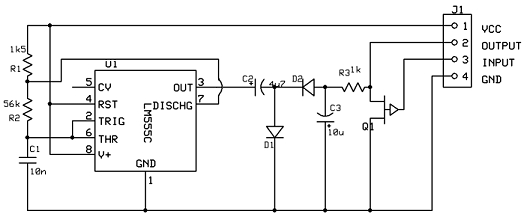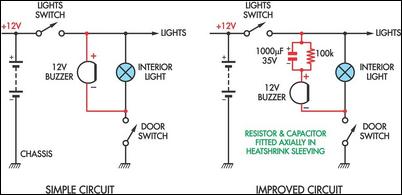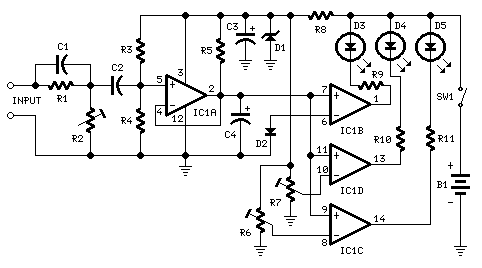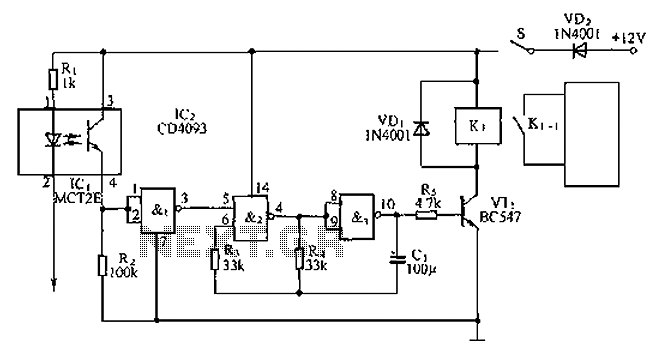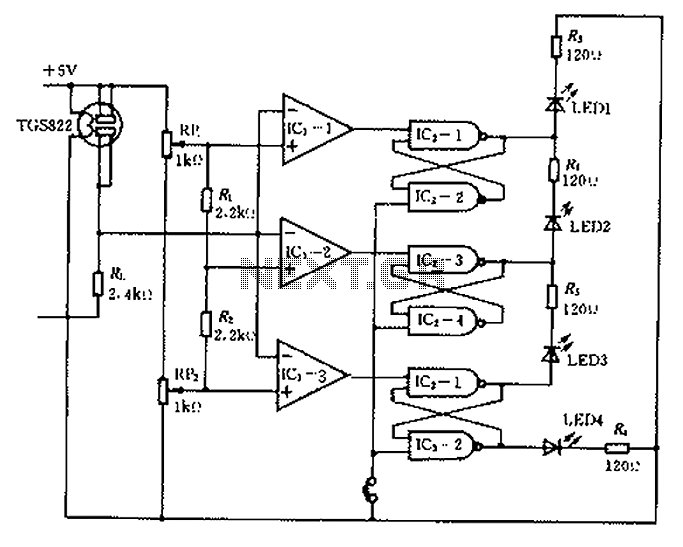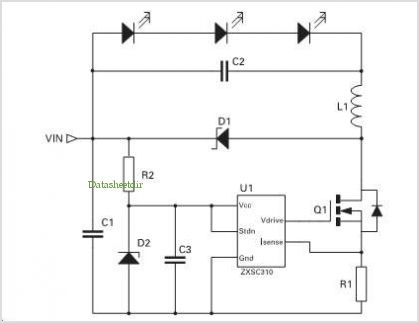
60kv ignition coil driver circuit
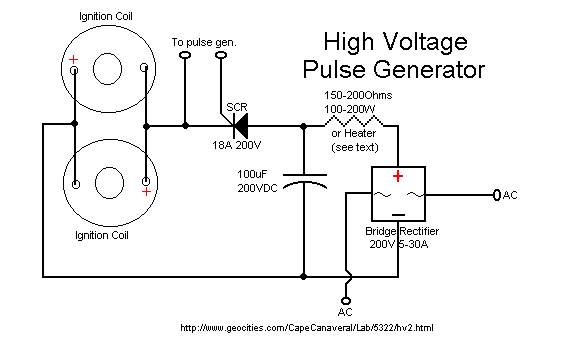
The ignition coil driver circuit described is a highly regarded design, reportedly created by Jochen Kronjaeger. It is intended to operate from a 230V source, although a modified version can function effectively at 120V. The circuit requires two ignition coils of the same type, a 100µF capacitor with a minimum voltage rating of 200VDC, and a full-wave bridge rectifier rated for approximately 5A at 200VDC. A large power resistor with a resistance of 150-200 ohms and a power rating of at least 100W is necessary; alternatively, an aquarium immersion heater can be used. Optional components include three 6A 200VDC SCRs, which can be sourced from Radio Shack, and a simple square wave pulse generator, such as a 555 timer circuit with variable frequency capability. The circuit is relatively easy to construct. If SCRs are unavailable, TRIACs can serve as substitutes, or relays, switches, or wires can be used to trigger the circuit, although this may lead to quick contact wear. The power resistor or heater is essential for discharging the capacitor safely, limiting current to a safe level. Without a current limiter, the power must be disconnected each time the capacitor is discharged. A household lightbulb can also be used as an alternative to a heater or resistor, providing a visual indication of capacitor charge status; the bulb will extinguish when the capacitor is fully charged.
The ignition coil driver circuit operates by utilizing the principles of inductive energy storage and discharge. The two ignition coils serve as inductive components that generate a high-voltage pulse when driven by the circuit. The 100µF capacitor is charged through the rectifier, which converts the AC input voltage into a DC voltage suitable for charging the capacitor. The full-wave bridge rectifier ensures that the capacitor receives a consistent voltage, allowing for effective energy storage.
The power resistor or aquarium heater plays a crucial role in managing the discharge of the capacitor. By limiting the current, it prevents damage to the circuit components during the discharge cycle. If a lightbulb is used instead, it not only limits the current but also provides a visual cue indicating the charge status of the capacitor. This feature is particularly useful for users who may not have access to more specialized components.
The optional SCRs can enhance the circuit's functionality by allowing for more controlled discharging of the capacitor. When triggered, the SCRs can facilitate rapid energy release from the capacitor into the ignition coils, generating a high-voltage pulse suitable for applications such as igniting fuel in combustion engines or other high-voltage ignition tasks. The inclusion of a square wave pulse generator adds versatility, enabling the user to adjust the frequency of the pulses, which can influence the performance characteristics of the ignition system.
In summary, this ignition coil driver circuit is a robust design capable of operating at different voltage levels with various components. Its flexibility in component selection and the potential for modifications make it an interesting project for electronics enthusiasts and professionals alike. Proper attention to component ratings and circuit configurations will ensure safe and effective operation.Here is probably the best ignition coil driver circuit that I have seen. As far as I know it was designed by Jochen Kronjaeger. You can find the original at Jochen`s High Voltage Page This circuit is designed to run from 230V, but I have came up with a circuit that will run from 120V about just as well. You will need to find two ignition coils (pr eferably of the same type), a 100uF with at least a 200VDC rating, a full-wave bridge rectifer with a rating of about 5A at 200VDC. A large power resistor with at about 150-200ohms resistance and a power capability of at least 100W, or you can use an aquarium immersion heater.
The next two things are optional, but they will make the project a lot more interesting. You might want to get about three 6A 200VDC SCRs. You can get these from Radio Shack. You might also want a simple square wave pulse generator. This can be just a simple 555 timer circuit. Make sure you can vary the frequency on it. This circuit is fairly easy to build. If you can`t get an SCR, you may also use a TRIAC as a substitute. If you can`t get either then you can use a relay, switch, or just two pieces of wire to trigger it. The contacts will probably be burned out soon though. The resistor or heater is used so that the power doesn`t need to be cut when you discharge the capacitor. It limits the current to a safe value when discharging the capacitor. If you choose not to use the current limiter, the power will have to be unplugged every time you discharge the capacitor.
If you cannot find a heater or power resistor you can also use a common household lightbulb. This will also give you a visual indication when the capacitor is charged. The bulb will go out when the capacitor is fully charged. 🔗 External reference
The ignition coil driver circuit operates by utilizing the principles of inductive energy storage and discharge. The two ignition coils serve as inductive components that generate a high-voltage pulse when driven by the circuit. The 100µF capacitor is charged through the rectifier, which converts the AC input voltage into a DC voltage suitable for charging the capacitor. The full-wave bridge rectifier ensures that the capacitor receives a consistent voltage, allowing for effective energy storage.
The power resistor or aquarium heater plays a crucial role in managing the discharge of the capacitor. By limiting the current, it prevents damage to the circuit components during the discharge cycle. If a lightbulb is used instead, it not only limits the current but also provides a visual cue indicating the charge status of the capacitor. This feature is particularly useful for users who may not have access to more specialized components.
The optional SCRs can enhance the circuit's functionality by allowing for more controlled discharging of the capacitor. When triggered, the SCRs can facilitate rapid energy release from the capacitor into the ignition coils, generating a high-voltage pulse suitable for applications such as igniting fuel in combustion engines or other high-voltage ignition tasks. The inclusion of a square wave pulse generator adds versatility, enabling the user to adjust the frequency of the pulses, which can influence the performance characteristics of the ignition system.
In summary, this ignition coil driver circuit is a robust design capable of operating at different voltage levels with various components. Its flexibility in component selection and the potential for modifications make it an interesting project for electronics enthusiasts and professionals alike. Proper attention to component ratings and circuit configurations will ensure safe and effective operation.Here is probably the best ignition coil driver circuit that I have seen. As far as I know it was designed by Jochen Kronjaeger. You can find the original at Jochen`s High Voltage Page This circuit is designed to run from 230V, but I have came up with a circuit that will run from 120V about just as well. You will need to find two ignition coils (pr eferably of the same type), a 100uF with at least a 200VDC rating, a full-wave bridge rectifer with a rating of about 5A at 200VDC. A large power resistor with at about 150-200ohms resistance and a power capability of at least 100W, or you can use an aquarium immersion heater.
The next two things are optional, but they will make the project a lot more interesting. You might want to get about three 6A 200VDC SCRs. You can get these from Radio Shack. You might also want a simple square wave pulse generator. This can be just a simple 555 timer circuit. Make sure you can vary the frequency on it. This circuit is fairly easy to build. If you can`t get an SCR, you may also use a TRIAC as a substitute. If you can`t get either then you can use a relay, switch, or just two pieces of wire to trigger it. The contacts will probably be burned out soon though. The resistor or heater is used so that the power doesn`t need to be cut when you discharge the capacitor. It limits the current to a safe value when discharging the capacitor. If you choose not to use the current limiter, the power will have to be unplugged every time you discharge the capacitor.
If you cannot find a heater or power resistor you can also use a common household lightbulb. This will also give you a visual indication when the capacitor is charged. The bulb will go out when the capacitor is fully charged. 🔗 External reference
